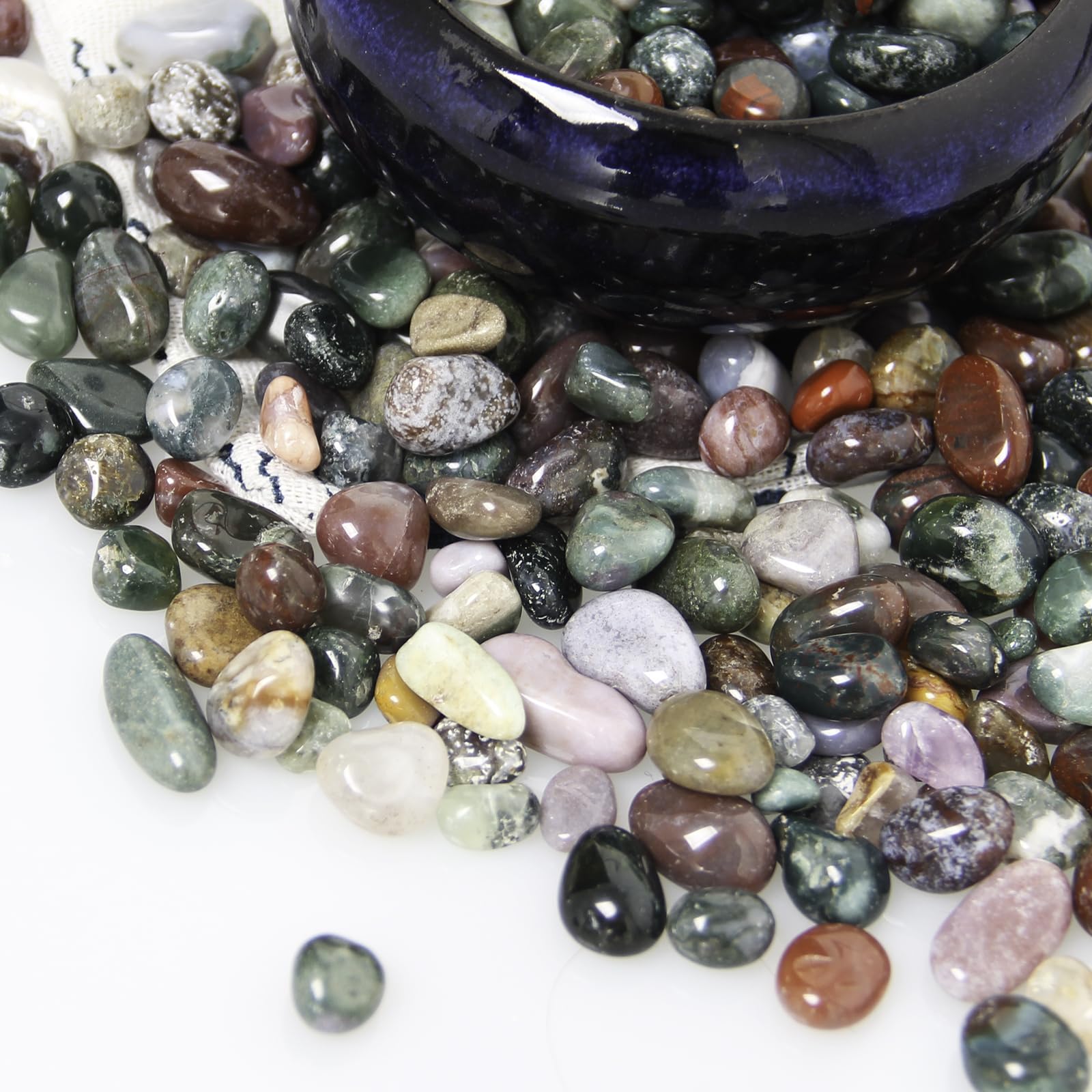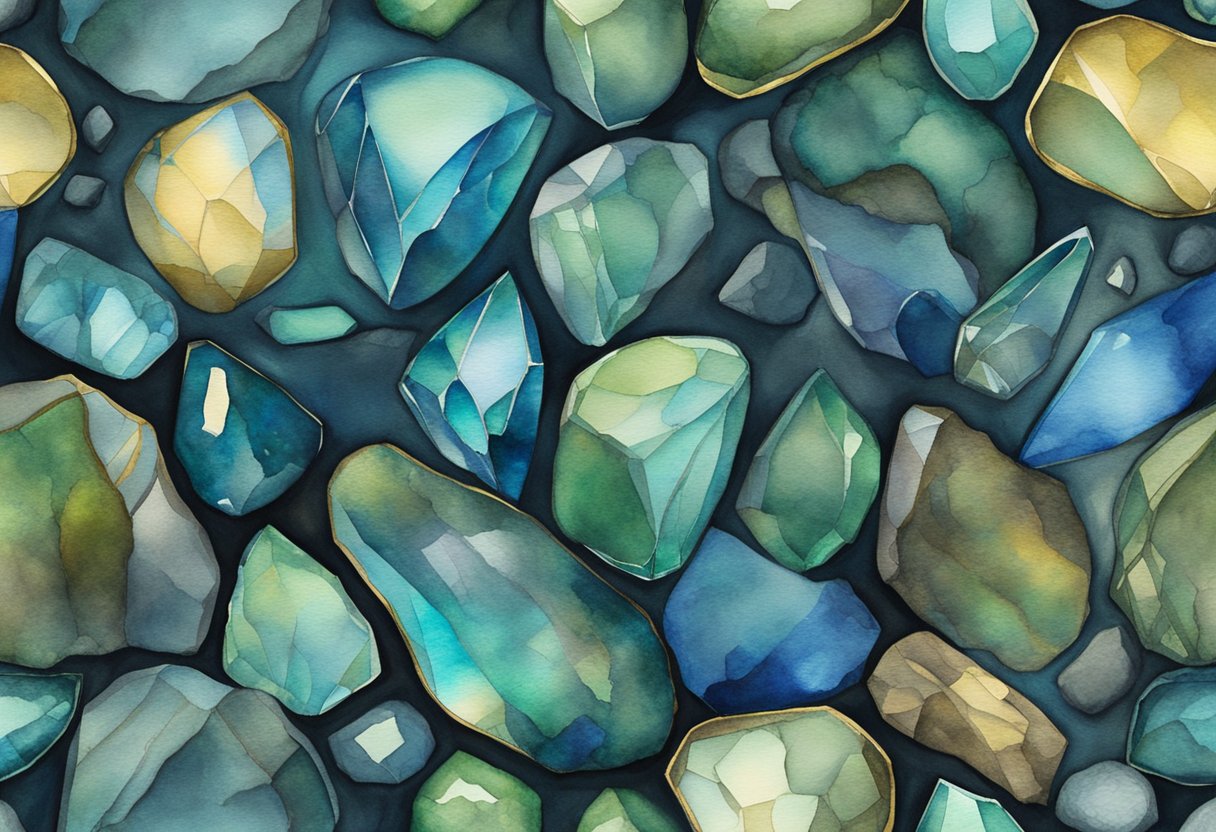
Magical Properties of Lapis Lazuli
Lapis lazuli, the "Stone of Wisdom," has been treasured since ancient Egypt for its celestial blue hue and powerful metaphysical properties. This guide explores its healing benefits, chakra alignment, jewelry uses, and how to harness...
Lapis Lazuli, a gemstone as ancient as the legends woven around it, has held the fascination of humanity for centuries. Its deep celestial blue remains the symbol of royalty and honor, gods and power, spirit and vision. It is a universal symbol of wisdom and truth. The alluring stone with its intrinsic luster has not only made its way into the adornments of the past but continues to enchant the present with its supposed metaphysical properties.
The enigmatic Lapis Lazuli has been revered through millennia, from the tombs of Egyptian pharaohs to the crowns of medieval kings. Its historical significance is matched only by its physical beauty, with hues of sapphire speckled with golden pyrite echoing the stars in a night sky. The stone is not just an object of visual delight but is also believed to carry healing qualities, aiding in intellectual clarity and emotional depth.
This gemstone is as practical as it is mystical. It maintains its place in the modern market, treasured for its beauty and the serene presence it is believed to bestow. It is still a popular choice for contemporary jewelry and ornamentation and is sought after for its unique character and historical allure. The care and maintenance of Lapis Lazuli are paramount to preserving its deep color and the luster that captures light and admiration equally.
Key Takeaways
- Lapis Lazuli is historically significant and recognized as a symbol of wisdom and truth.
- Believed to possess healing properties, it aids in fostering clarity and emotional well-being.
- Its enduring appeal makes it a prized choice for modern jewelry and decorative pieces.
Historical Significance

Lapis lazuli’s journey through the annals of time shines with a celestial blue that echoes its historical reverence and global reach. This cherished mineral held the gaze of ancient royalty and inspired cultures far and wide.
Ancient Use in Egypt
In the land where the desert meets the life-giving Nile, the ancient Egyptians revered lapis lazuli as the stone of the gods. Royalty such as Tutankhamun adorned themselves with lapis jewelry, and artisans crafted the iconic funeral mask with the deep blue stone. The ancient Egyptians saw it as a symbol of protection, wisdom, and truth, believing it held a connection to the heavens.
- Location of Discovery: Egypt
- Notable Uses: Jewelry, Carving, Decoration
- Associated Symbols: Protection, Wisdom, Truth
Global Discoveries
As the wheel of time turned, lapis lazuli found favor across different lands. Mesopotamian civilizations celebrated it in their myths, afghanistan and chile, while later, Russia and the USA coveted the rich mineral for its ornamental and artistic value. Afghanistan’s mines have been a primary source for over 6,000 years, making it a historical cornerstone in the narrative of lapis.
- Notable Sources: Afghanistan, Chile, Russia, USA
- Historical Importance: Artistic, Cultural, Ornamental
- Cultural Contributions: Mesopotamian Myths, Renaissance Artworks
Through these ancient uses and discoveries, the historical significance of lapis lazuli becomes evident. Each civilization it touched was imprinted with a legacy of admiration for this gemstone of the night sky.
Healing and Metaphysical Benefits
Lapis Lazuli is often hailed as a beacon of inner wisdom and a catalyst for psychic enlightenment. This revered stone is believed to carry an ocean’s depth of healing attributes and the sky’s expanse of metaphysical properties.
Chakra Alignment
Lapis Lazuli is synonymous with the third eye chakra, the center of intuition and perception. By aligning this chakra, the stone fosters a stronger connection to consciousness and awareness. The blue hues of the crystal are known to open the gateway to inner wisdom, blending the physical plane with the spiritual. It also affects the throat chakra, encouraging articulate expression and truth.
- Third eye chakra: Enhances intuition and psychic abilities.
- Throat chakra: Promotes honest expression and communication.
Emotional and Spiritual Healing
The stone’s gentle vibrations offer a shroud of protection against negative energies, clearing the path for emotional balance and tranquility. Individuals seeking to deepen their self-awareness and empathy may find solace in Lapis Lazuli’s comforting embrace, which is known to strengthen relationships and instill harmony and compassion.
- Promotes emotional healing and inner peace.
- Strengthens relationships, compassion, and harmony.
- Encourages self-awareness and confidence.
Lapis Lazuli in Jewelry and Ornamentation

Lapis lazuli has been cherished for its deep blue hue and twinkling pyrite inclusions, often resembling a starlit sky. It graces various forms of jewelry, with both traditional allure and contemporary appeal.
Traditional and Modern Design
Lapis lazuli steals the show in jewelry design, commanding attention with its royal blue color punctuated by flecks of pyrite that mimic a gold-like sparkle. Traditionally, this gemstone served as a centerpiece in necklaces and signet rings, signifying power and status. Today, designers continue to honor its legacy, incorporating lapis lazuli into modern pieces that enchant seekers of both heritage and fashion. Bold contrasts arise when set against white metals, while in harmony with gold, lapis lazuli enhances its inherent regality.
-
Types of Jewelry:
- Necklaces
- Bracelets
- Rings
- Brooches
-
Common Combinations:
- Lapis lazuli with gold and pyrite inclusions
- Contrasting pairings with white metals like silver or white gold
- Complementary settings with sapphire or turquoise to create a palette of blues
Care and Maintenance
Lapis lazuli’s beauty is equaled by the care it demands; it is not as hard as sapphire or as resilient as turquoise. Owners of lapis lazuli jewelry must treat their adornments with the delicacy of a flower. The gem is best kept away from the abrasions and strains that bracelets or rings might encounter. To maintain its celestial gleam, a gentle cleansing with mild soap and water is recommended, steering clear of harsh chemicals and high temperatures. Storing lapis lazuli jewelry separately ensures that the softer stone remains unscathed by harder materials.
-
Cleaning Tips:
- Use a soft, lint-free cloth
- Mild soap and water solution
- Avoid ultrasonic cleaners
-
Storage Advice:
- Separate compartments or pouches
- Soft lining to prevent scratches
- Cool, dry environment
Influence in Culture and Beliefs

Lapis lazuli has long been esteemed for its deep celestial blue, a symbol of the night sky bedecked with stars. Societies throughout history have revered it not only for its beauty but for its supposed metaphysical properties, associating the stone with a host of spiritual and intellectual benefits.
Symbolism and Significance
The majestic hues of lapis lazuli have been a beacon of knowledge and truth. In ancient times, it was a stone of wisdom and enlightenment, often adorning the garb of scholars and priests. Lapis lazuli’s connection to wisdom and understanding is seen as an aid to enhancing one’s insight and ability to decipher complex concepts.
This gem has been associated with the third eye chakra, the center of intuition and foresight, and the throat chakra, which governs communication. As such, it’s believed to foster clear expression and serenity in speech.
- Cultural Artifacts: Often found in the treasures of Egyptian pharaohs.
- Thematic Element: Symbolizes truth and enlightenment in literary works.
- Astrological Correspondence: Linked with the month of December as a birthstone.
Astrological Associations
Lapis lazuli’s rich blue depth is seen as mirroring the infinite cosmos, attributing to it a connection with astrology. Those born under its sign are thought to possess an innate courage, friendship, and fidelity—qualities woven into the fabric of daily life.
Astrologers often recommend the stone to those seeking harmony and love, believing in its ability to cleanse the soul and mind, allowing for genuine connections and tranquility. The ancients, looking to the heavens for guidance, saw parallels in the complexity of the universe and the simplicity of genuine friendship.
- Zodiac Sign: Suggested to be beneficial for Sagittarius, promoting courage and optimism.
- Feng Shui: Employed to enhance serenity and balance within living spaces.
- Angelic Relations: Thought to bring one closer to guardian angels and the tranquility they provide.
In every aspect, lapis lazili’s radiance is believed to usher in a symphony of balance, beckoning peace and understanding to those who hold or wear it.
Contemporary Uses and Practices
Lapis Lazuli serves as a beacon for those seeking a sanctuary from the tumultuous sea of stress, guiding them toward serenity and emotional balance. It’s not just a feast for the eyes; its applications stretch far beyond visual splendor.
Therapeutic Applications
Individuals looking for solace in the healing arms of nature often turn to Lapis Lazuli for its supposed therapeutic properties. The stone’s high-frequency vibrations are said to provide a shield against psychic attack, promoting spiritual growth while fostering a clearer perception of the world.
- Stress Relief: Many believe that Lapis Lazuli’s soothing energy can diffuse stress, offering a cloak of calmness in its stead.
- Emotional Harmony: By balancing the emotions, this stone is often used to ease the ebbs and flows of the soul’s ocean, anchoring it in tranquil waters.
- Supporting Perception: Advocates suggest that Lapis Lazuli can sharpen perception, enhancing learning and one’s understanding of their inner truth.
Artistic and Decorative Purposes
Craftsmen and artists across the globe draw inspiration from the stone’s palette, integrating its rich blues and celestial patterns into their creations. Not only does Lapis Lazuli embed creative energy into artistic endeavors, but it also infuses spaces with a sense of deep tranquility.
- Creative Work: Artists often employ the stone seeking to unlock wellsprings of creative ideas, hoping its rumored inspirational powers will invigorate their work.
- Home Decor: Utilized in beads, carvings, and architectural elements, Lapis Lazuli bestows an aura of learned sophistication and ancient wisdom to any space.
By weaving Lapis Lazuli into daily practices, whether through meditation, artistic pursuits, or simply as a touchstone for peace, one enlists an ancient ally believed to resonate with the very vibrations of human growth and enlightenment.
Caring for Lapis Lazuli

Maintaining the allure and mystical qualities of Lapis Lazuli calls for specific care and protection methods. Heed these guidelines to ensure this gemstone’s longevity and to continually bask in its enigmatic charm.
Cleaning Methods
Lapis Lazuli, with its celestial hue, requires delicate cleansing rituals to preserve its integrity. This stone, scoring a 5 to 5.5 on the Mohs hardness scale, isn’t impervious to damage by stronger materials.
-
Mild Soap Solution: Submerge the gemstone in a bowl filled with lukewarm water and a touch of mild soap.
- Use a soft brush to gently sweep away any accumulated impurities.
- Rinse thoroughly with clean water to ensure the removal of soapy residue.
- Dry Gently: After cleansing, pat the Lapis Lazuli dry with a soft cloth to prevent water spots or streaking.
Lapis Lazuli must never be soaked in harsh chemicals or acidic solutions, as this could damage its polished surface and vivid color.
Storage and Handling
Storage of Lapis Lazuli follows the principle of shielding it from harm’s path. This gem thrives in environments that emulate the gentle embrace of night’s darkness:
- Separate Compartments: To avoid scratches, store your Lapis Lazuli in individual fabric-lined compartments or wrap it in a soft cloth.
- Controlled Environment: Keep the stone away from direct sunlight, extreme temperatures, and humidity to safeguard its deep blue hue.
Handling Lapis Lazuli with care prolongs its life and preserves its essence. Always lift the stone with a tender yet secure grasp to protect it from unfortunate tumbles that could mark its surface or fracture its spirit.
By adhering to these care practices, your Lapis Lazuli will remain a beacon of ancient mystique and natural beauty, safeguarding its magical properties and enveloping the wearer in its protective energies.
Imitations and Synthetic Variations

In the realm of gemstones, lapis lazuli stands out for its mesmerizing deep blue hue, reminiscent of the midnight sky studded with golden stars. However, distinguishing the genuine article from clever counterfeits or alternative blue gemstones requires a discerning eye and informed knowledge.
Recognizing Genuine Lapis Lazuli
True lapis lazuli is characterized by its iconic deep blue color, interspersed with golden flecks of pyrite and white streaks of calcite. These imperfections are not flaws but hallmarks of authenticity. One should pay special attention to uniformity in color; a stone that boasts a perfect deep blue without traces of gold or white might indicate a synthetic creation.
-
Real Lapis Lazuli Traits:
- Deep blue color with variations
- Inclusions of pyrite (gold flecks)
- Calcite presence (white streaks)
Comparison with Other Blue Gemstones
Other blue gemstones may masquerade as lapis lazuli, yet they lack the signature combination of materials and hues that define lapis. For example, sodalite shares a similar blue color but often lacks lapis lazuli’s golden sparkles. Sapphire, while a deep blue as well, is typically more transparent and lacks the characteristic inclusions found in genuine lapis lazuli. Meanwhile, turquoise sports a distinctly different spectrum of blue and is usually peppered with matrix patterns which make it easier to distinguish from lapis lazuli.
-
Look-Alike Gemstone Traits:
- Sodalite: Similar blue, no pyrite flecks
- Sapphire: Transparent, uniform deep blue
- Turquoise: Lighter blue, matrix patterns present
As gem enthusiasts and consumers navigate the market, they should cultivate a perceptive eye to identify the unique beauty of genuine lapis lazuli amidst a sea of imitations and synthetic variations.
Enhancing Personal Experiences with Lapis Lazuli

Lapis Lazuli, often likened to the stars gleaming in the midnight sky, serves as a bridge to heightened personal experiences. This deep blue stone unfurls its magical properties to enrich practices of meditation and mindfulness, while also weaving its serene essence into the tapestry of daily life.
Meditation and Mindfulness Practices
Lapis Lazuli is celebrated for fostering a deeper connection with one’s inner wisdom and intuition during meditation. Practitioners find that holding or placing Lapis Lazuli near them can facilitate an opening of the third eye, the chakra associated with insight and awareness. Here is how individuals can enhance their meditation and mindfulness sessions:
- For Intuition: Positioning Lapis Lazuli on the brow during meditation may amplify psychic abilities and strengthen the bond with one’s internal compass.
- Aiding Concentration: As a stone known to usher in calmness, it can assist in dispelling surrounding distractions, providing a focused environment conducive to mindfulness.
Incorporating into Daily Life
Integrating Lapis Lazuli into everyday routines extends its mystical benefits beyond structured spiritual practices. Many find that it promotes self-expression and communication when worn as jewelry, especially near the throat chakra. Lapis can be a unobtrusive companion:
- In the workplace: Keeping a piece on the desk can aid in clear communication and wisdom, essential for decision-making.
- During social interactions: As a talisman, Lapis Lazuli may assist in engaging in conversations with authenticity and confidence.
Lapis Lazuli’s alluring hue and tranquil presence offer a sanctuary of peace for those who seek solace in its embrace, imbuing daily tasks with a harmonious and enlightened perspective.
Conclusion

Lapis lazuli, a gemstone as ancient as the sands of time, brings with it a rich legacy of healing and metaphysical properties. Revered by many cultures for its deep celestial blue, it’s a beacon of balance and harmony. Individuals seeking a touchstone for truth often turn to this noble mineral. It is said to unlock the gates of insight, offering a mirror to the soul, and providing a pathway to authenticity.
Within its glimmering depths, one finds the serenity of the night sky. The gem’s believed ability to facilitate inner peace aligns closely with the human quest for equilibrium in chaotic times. By purportedly connecting the physical and celestial realms, lapis lazuli may serve as a guide for those navigating the inner landscape of emotions and thoughts.
For the seekers, the dreamers, and the healers, lapis lazuli stands as an emblem of wisdom. It’s not just an object of visual splendor; many claim it to be a source of revelations and a tool for self-expression. However, as with all things in life, individual experiences with lapis lazuli will vary, and its effects are as unique as the person who holds it.
The legacy of lapis lazuli is woven through countless histories and traditions, yet it continues to captivate people in the modern era. Its enduring appeal lies in the intertwining of its aesthetic beauty with its storied past, making it a timeless treasure for those drawn to its allure.




 https://witchyhour.com
https://witchyhour.com